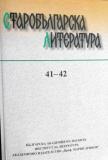Две славянски венециански издания от XVIII в. с литургическо съдържание. Наставление върху Тайнствата на Захарий Орфелин и Епитом на Дионисий Новакови
Two Eighteenth-Century Slavic Liturgical Publications from Venice: Zaharije Orfelin’s On the Sacraments and Dionisije Novaković’s Epitome
Author(s): Georgi Minczew Subject(s): Language studies
Published by: Институт за литература - БАН
Summary/Abstract: TWO EIGHTEENTH-CENTURY SLAVIC LITURGICAL PUBLICATIONS FROM VENICE: ZAHARIJE ORFELIN'S ON THE SACRAMENTS AND DIONISIJE NOVAKOVIĆ'S EPITOME GEORGI MINCZEW (ŁÓDŹ) (Summary) The study analyzes the content of two little-known liturgical works (mystagogies) written by Serbian theologians: A Short and Simple Teaching on the Seven Sacraments (Kratkoe da prostoe o sedmych tajnstvach uchitelskoe nastavlenie) by Zaharije Orfelin (1726–1785) and The Epitome, or a Short Story of the Holy Temple (Epitom ili kratkija skazanija sveshtenago hrama) by Dionisije Novaković (1705–1767). Both texts/treatises were published by the Venice-based Greek printer Dimitrios Theodosios in 1763 and 1767, respectively. The analysis concentrates on these texts’ dependence on certain early Church Slavic prints, particularly the Skrizhal’ published in 1665 in Moscow – the most widely read work on theology among the Orthodox Slavs in the 17th and 18th centuries. Other works that appear to have influenced the Serbian commentators include certain late Byzantine mystagogies, the most significant of which are De sacra liturgia and Expositio de divino templo by St. Symeon of Thessaloniki (second half of the 14th century – 1429). The appearance and spread among the Balkan Slavs of two printed mystagogies is the outcome of the more general processes connected with the struggle of the Orthodox Slavic nations (living under Ottoman or Austro-Hungarian rule) to find their own approach to theology – in this particular case, to liturgics. This approach, which has its origins in Greek and Russian religious thought, develops in the second half of the 18th century into a plan to enrich the Eastern tradition with ideas taken over from Western theology – a plan which was never carried out.
Journal: Старобългарска литература
- Issue Year: 2009
- Issue No: 41-42
- Page Range: 473-488
- Page Count: 16
- Language: Bulgarian
- Content File-PDF

